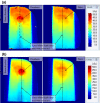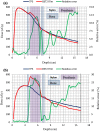Dose comparison between Gafchromic film, XiO, and Monaco treatment planning systems in a novel pelvic phantom that contains a titanium hip prosthesis
- PMID: 28741892
- PMCID: PMC5874810
- DOI: 10.1002/acm2.12141
Dose comparison between Gafchromic film, XiO, and Monaco treatment planning systems in a novel pelvic phantom that contains a titanium hip prosthesis
Abstract
The presence of metallic prostheses during external beam radiotherapy of malignancies in the pelvic region has the potential to strongly influence the dose distribution to the target and to tissue surrounded by the prostheses. This study systematically investigates the perturbation effects of unilateral titanium prosthesis on 6 and 15 MV photon beam dose distributions using Gafchromic EBT2 film measurements in a novel pelvic phantom made out of a stack of nylon slices. Comparisons were also made between the film data and dose calculations made on XiO and Monaco treatment planning systems. The collapsed cone algorithm was chosen for the XiO and the Monte Carlo algorithm used on Monaco is XVMC. Transmission measurements were taken using a narrow-beam geometry to determine the mass attenuation coefficient of nylon = 0.0458 cm2 /g and for a water-equivalent RW3 phantom, it was 0.0465 cm2 /g. The perturbation effects of the prosthesis on dose distributions were investigated by measuring and comparing dose maps and profiles. The magnitude of dose perturbations was quantified by calculating dose enhancement and reduction factors using field sizes of 3 × 3, 5 × 5, 10 × 10, and 15 × 15 cm2 . For the studied beams and field sizes, dose enhancements between 21 and 30% and dose reductions between 15 and 21% were observed at the nylon-prosthesis interface on the proximal and distal sides of the prosthesis for film measurements. The dose escalation increases with beam energy, and the dose reduction due to attenuation decreases with increasing beam energy when compared to unattenuated beam data. A comparison of film and XiO depth doses for the studied fields gave relative errors between 1.1 and 23.2% at the proximal and distal interfaces of the Ti prosthesis. Also, relative errors < 4.0% were obtained between film and Monaco dose data outside the prosthesis for 6 and 15 MV lateral opposing fields.
Keywords: dose perturbations; pelvic phantom; photon beams; prosthesis.
© 2017 The Authors. Journal of Applied Clinical Medical Physics published by Wiley Periodicals, Inc. on behalf of American Association of Physicists in Medicine.
Figures












References
-
- Reft C, Alecu R, Das IJ, et al. Dosimetric considerations for patients with HIP prostheses undergoing pelvic irradiation. Report of the AAPM Radiation Therapy Committee Task Group 63. Med Phys. 2003;30:1162–1182. - PubMed
-
- Spezi E, Palleri F, Angelini AL, et al. Characterization of materials for prosthetic implants using the BEAMnrc Monte Carlo code. J Phys Conf Ser. 2007;74:021016.
-
- Carolan M, Dao P, Fox C, et al. Effect of hip prostheses on radiotherapy dose. Australas Radiol. 2000;44:290–295. - PubMed
-
- Wieslander E, Knöös T. Dose perturbation in the presence of metallic implants: treatment planning system versus Monte Carlo simulations. Phys Med Biol. 2003;48:3295–3305. - PubMed
-
- Sibata CH, Mota HC, Higgins PD, et al. Influence of hip prostheses on high energy photon dose distributions. Int J Radiat Oncol Biol Phys. 1990;18:455–461. - PubMed
MeSH terms
Substances
LinkOut - more resources
Full Text Sources
Other Literature Sources

